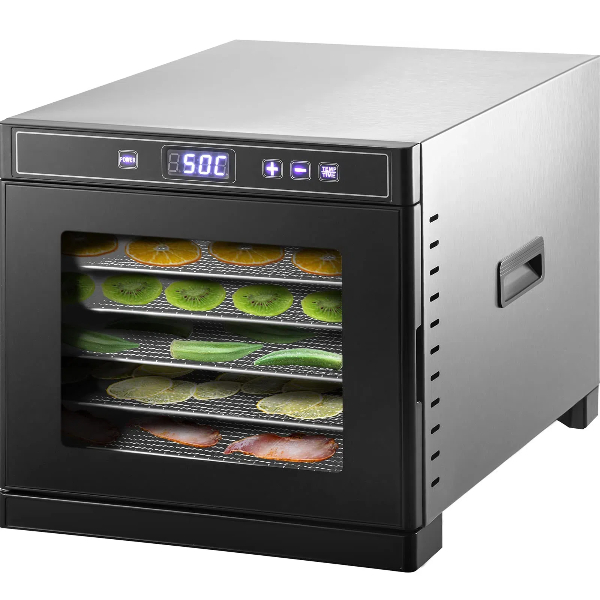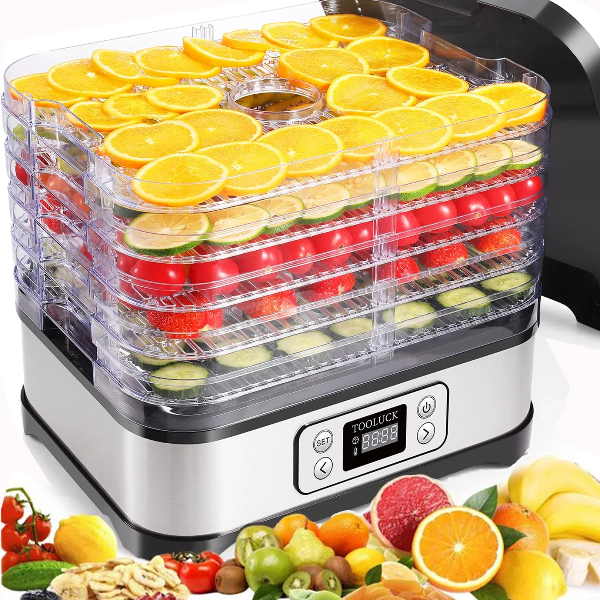
Content Menu
● Introduction to Food Drying Machines
● The Science Behind Food Drying
>> How Food Drying Machines Work
● Types of Food Drying Machines
>> 1. Stackable Tray Dehydrators
>> 2. Box and Shelf Dehydrators
>> 3. Commercial-Grade Dehydrators
>> 4. Solar Dehydrators
● Benefits of Using Food Drying Machines
● Choosing the Right Food Drying Machine
>> Capacity
>> Temperature Control
>> Airflow
>> Noise Level
>> Energy Efficiency
● Popular Foods to Dry in Food Drying Machines
● Tips for Successful Food Drying
● Storing Dried Foods
● Creative Uses for Dried Foods
● Maintenance and Cleaning of Food Drying Machines
● The Future of Food Drying Technology
● Conclusion
● Frequently Asked Questions
>> 1. How long does it take to dry food in a food drying machine?
>> 2. Is it safe to leave a food drying machine running overnight?
>> 3. How do I know when my food is sufficiently dried?
>> 4. Can I dry different types of food together in the same batch?
>> 5. How long do home-dried foods last?
Introduction to Food Drying Machines
Food drying machines, also known as food dehydrators, have revolutionized the way we preserve food in our homes and in commercial settings. These ingenious devices use controlled heat and airflow to remove moisture from various foods, extending their shelf life while retaining much of their nutritional value and flavor. In this comprehensive guide, we'll explore the world of food drying machines, their benefits, types, and how to make the most of this technology in your kitchen or business.
The Science Behind Food Drying
Food drying is an ancient preservation technique that has been modernized with the advent of electric food drying machines. The process works by removing moisture from food, which inhibits the growth of bacteria, yeasts, and molds. By reducing the water activity in foods, we can significantly extend their shelf life without the need for chemical preservatives or refrigeration.
How Food Drying Machines Work
Modern food drying machines typically consist of the following components:
1. Heating element
2. Fan for air circulation
3. Trays or racks for food placement
4. Adjustable thermostat
5. Timer
The heating element warms the air inside the machine, while the fan circulates this warm air around the food. As the warm air passes over the food, it picks up moisture, which is then vented out of the machine. This continuous process gradually reduces the moisture content of the food until it reaches the desired level of dryness.

Types of Food Drying Machines
There are several types of food drying machines available on the market, each with its own advantages:
1. Stackable Tray Dehydrators
These are the most common type of food drying machines for home use. They consist of a base unit with a heating element and fan, and multiple trays that stack on top of each other. Stackable tray dehydrators are versatile and allow you to dry different types of foods simultaneously.
2. Box and Shelf Dehydrators
These units resemble small ovens with removable shelves. They often provide more consistent drying results due to their enclosed design and are suitable for both home and small commercial use.
3. Commercial-Grade Dehydrators
Large-scale operations use industrial food drying machines that can handle high volumes of produce. These machines often feature advanced controls for precise temperature and humidity management.
4. Solar Dehydrators
For those interested in eco-friendly options, solar dehydrators harness the power of the sun to dry foods. While they require no electricity, they are dependent on weather conditions and may take longer to dry foods compared to electric models.
Benefits of Using Food Drying Machines
Investing in a food drying machine offers numerous advantages:
1. Extended food preservation without additives
2. Retention of nutritional value
3. Space-saving food storage
4. Reduction of food waste
5. Cost-effective in the long run
6. Ability to create healthy snacks at home
7. Preservation of seasonal fruits and vegetables for year-round enjoyment
Choosing the Right Food Drying Machine
When selecting a food drying machine, consider the following factors:
Capacity
Think about how much food you plan to dry at once. Home users might be satisfied with a smaller unit, while those who grow their own produce or buy in bulk may need a larger capacity machine.
Temperature Control
Look for a machine with adjustable temperature settings. Different foods require different drying temperatures for optimal results.
Airflow
Efficient air circulation is crucial for even drying. Some models offer horizontal airflow, which is generally more effective than vertical airflow systems.
Noise Level
Since drying can take several hours, consider the noise level of the machine, especially if you plan to run it overnight or in shared living spaces.
Energy Efficiency
Check the power consumption of the unit, as energy-efficient models can help keep operating costs down.

Popular Foods to Dry in Food Drying Machines
Food drying machines are incredibly versatile and can be used to dehydrate a wide variety of foods:
1. Fruits: Apples, bananas, berries, mangoes, pineapples
2. Vegetables: Tomatoes, carrots, peppers, onions, zucchini
3. Herbs: Basil, oregano, thyme, parsley, dill
4. Meats: Beef jerky, turkey jerky, fish
5. Nuts and seeds
6. Flowers for tea or decoration
Tips for Successful Food Drying
To get the best results from your food drying machine, follow these tips:
1. Prepare foods uniformly: Cut fruits and vegetables into even-sized pieces for consistent drying.
2. Pre-treat fruits: Dip fruits prone to browning in lemon juice or ascorbic acid solution before drying.
3. Blanch vegetables: Briefly blanch vegetables before drying to preserve color and nutrients.
4. Rotate trays: If your machine doesn't have a rotating feature, manually rotate the trays during the drying process for even results.
5. Allow proper spacing: Don't overcrowd the trays; leave space between food pieces for air circulation.
6. Check for dryness: Foods should be leathery or crisp when properly dried, depending on the type.
7. Cool before storing: Allow dried foods to cool completely before packaging to prevent condensation.
Storing Dried Foods
Proper storage is crucial to maintain the quality of your dried foods:
1. Use airtight containers or vacuum-sealed bags.
2. Store in a cool, dark, and dry place.
3. Label containers with the contents and drying date.
4. Check periodically for any signs of moisture or mold.
Creative Uses for Dried Foods
Dried foods are not just for snacking; they can be incorporated into various culinary creations:
1. Add dried fruits to baked goods, cereals, or trail mixes.
2. Use dried vegetables in soups, stews, and casseroles.
3. Grind dried herbs for homemade spice blends.
4. Create fruit leathers for a healthy snack alternative.
5. Make your own tea blends with dried fruits and herbs.
6. Use dried flowers for decorating cakes or making potpourri.
Maintenance and Cleaning of Food Drying Machines
To ensure your food drying machine continues to perform optimally:
1. Clean trays and the interior after each use with warm, soapy water.
2. Check and clean air filters regularly if your model has them.
3. Wipe down the exterior with a damp cloth.
4. Store the machine in a clean, dry place when not in use.
5. Periodically check the heating element and fan for proper function.
The Future of Food Drying Technology
As technology advances, we can expect to see innovations in food drying machines:
1. Smart features with mobile app integration for remote monitoring and control.
2. More energy-efficient models with improved insulation and heat recovery systems.
3. Advanced sensors for precise moisture content measurement.
4. Combination units that incorporate freeze-drying capabilities.
5. Increased use of sustainable materials in machine construction.
Conclusion
Food drying machines offer a fantastic way to preserve the bounty of nature, reduce food waste, and create healthy snacks. Whether you're a home cook looking to extend the life of your garden produce or a small business owner seeking to create unique dried food products, there's a food drying machine out there to suit your needs. By understanding the technology, choosing the right machine, and following best practices for food preparation and storage, you can unlock a world of culinary possibilities and enjoy the benefits of dried foods year-round.

Frequently Asked Questions
1. How long does it take to dry food in a food drying machine?
Answer: Drying times can vary greatly depending on the food type, its water content, the machine's efficiency, and the desired level of dryness. On average, fruits can take 6-12 hours, vegetables 4-8 hours, and meats for jerky 4-15 hours. Always refer to your machine's manual and recipe guidelines for specific drying times.
2. Is it safe to leave a food drying machine running overnight?
Answer: Most modern food drying machines are designed to be left running for extended periods, including overnight. However, it's important to follow the manufacturer's safety guidelines, ensure proper ventilation, and place the machine on a heat-resistant surface away from flammable materials.
3. How do I know when my food is sufficiently dried?
Answer: Properly dried fruits should be pliable and leathery with no pockets of moisture. Vegetables should be brittle or crisp. Jerky should be leathery but not crack when bent. You can also test for dryness by cutting a piece in half – there should be no visible moisture inside.
4. Can I dry different types of food together in the same batch?
Answer: While it's possible to dry different foods together, it's generally not recommended. Different foods often require different drying times and temperatures. Additionally, flavors can transfer between foods during the drying process. For best results, dry similar foods together and clean the machine thoroughly between batches of different food types.
5. How long do home-dried foods last?
Answer: When properly dried and stored in airtight containers in a cool, dark place, most dried foods can last 6-12 months. Some dried foods, like herbs, can last even longer. However, it's best to consume dried foods within a year for optimal quality and nutritional value. Always check for signs of spoilage before consuming stored dried foods.












